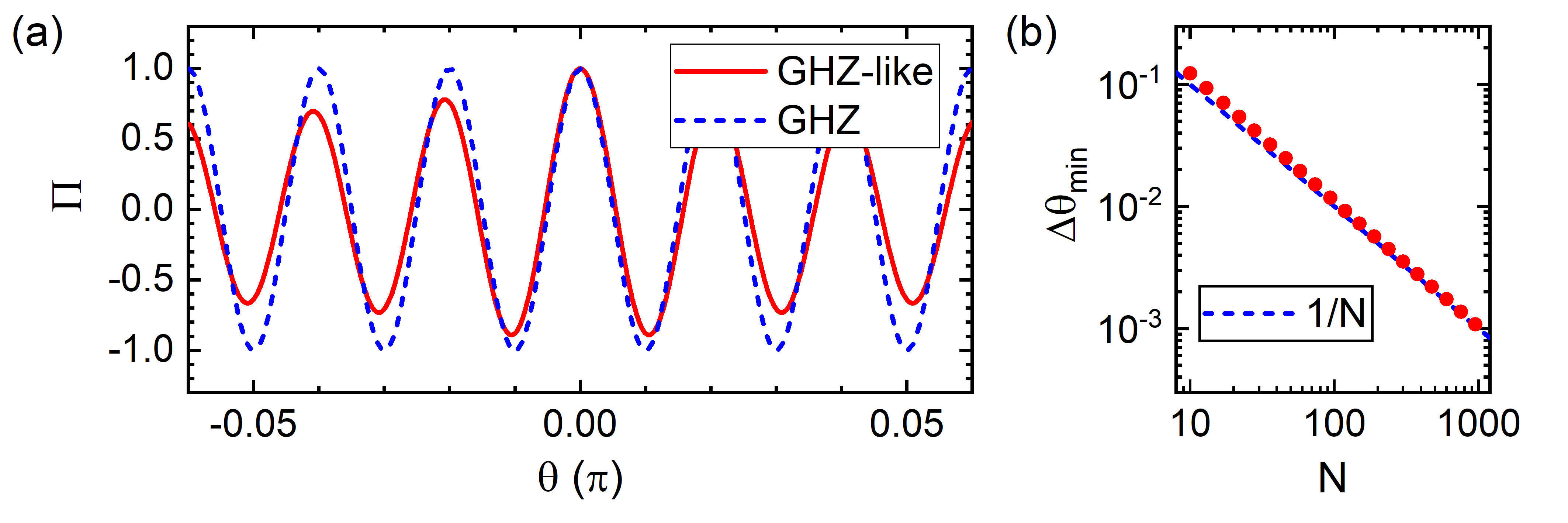Recently, a research group led by Prof. Yong-Chun Liu from Tsinghua’s Department of Physics has proposed a new method of generating Schrödinger cat state, which can be used to create GHZ-like (Greenberger-Horne-Zeilinger-like) state in collective-spin systems. The research results were published in Physical Review Letters under the title of “Fast Generation of GHZ-like States Using Collective-Spin XYZ Model”.
Schrödinger cat state generally refers to the quantum superposition of two macroscopically distinct states. A typical type of Schrödinger cat states is the multiparticle maximally entangled state (i.e. GHZ state), which not only possesses ideal property of entanglement, but also achieves Heisenberg-limited measurement precision, thus is widely applied in quantum information science and quantum metrology. However, GHZ state is extremely fragile to decoherence and particle losses, making it difficult to be created in large systems using traditional methods (such as using quantum logic gates or one-axis twisting interaction). Therefore, it is of great importance to find new methods to create GHZ state.
The researchers introduced three-body interaction into collective-spin systems and proposed a new collective-spin model named as XYZ model. In comparison to two-body collective-spin interactions (such as two-axis twisting), the phase-space structure of this model is richer [fig. 1(a1)], enabling the quasi-probability distribution of the spin state to "stop" at two opposite poles on the generalized Bloch sphere. With the aid of this model, an unentangled coherent spin state can evolve to a GHZ-like state in a short time [fig. 1(b1), (c1)].

Fig. 1. The comparison of the XYZ model (up) and the two-axis twisting model (down). (a) phase-space trajectories, (b) Time evolution of the quantum state (represented with Husimi Q function), (c) The quantum state in t=tc (represented with polar coordinates).
The researchers also proposed a pulse scheme to realize the XYZ model. By applying periodic rotation pulses along two perpendicular axes to the commonly existed one-axis twisting interaction, the spin state undergoes sequential three-axis twisting. The proposed pulse sequences are shown in fig. 2(a). The effective XYZ model is synthesized due to the noncommutativity of these three periods of evolution. In comparison to creating GHZ state directly with one-axis twisting interaction, the required evolution time of this scheme is inversely proportional to the particle number N and is greatly shortened, especially in the case of large particle number.

Fig. 2. The pulse scheme to generate the effective XYZ model. (a) An illustration of the proposed pulse sequences. Red and blue boxes correspond to π/2 pulses along x and y axes, respectively, (b) The required time to create the GHZ-like state.
The GHZ-like state generated using this scheme achieves a high precision in parity measurements. The result is very similar to the standard GHZ state, approaching the Heisenberg limit, as shown in fig. 3.

Fig. 3. Parity oscillation of the GHZ-like state. (a) The comparison of the parity oscillations for the GHZ-like state and the standard GHZ state, (b) The measurement precision of the GHZ-like state in parity measurement, very closed to the Heisenberg limit shown with the dashed blue line.
In noisy environments, the influence of decoherence is obviously weakened due to the short evolution time of this scheme. They compare the XYZ scheme and the one-axis twisting scheme under the impact of superradiance, and find the XYZ scheme outperforms the latter as particle number and the intensity of decoherence get larger. In addition, the GHZ-like state generated using the XYZ model is also more robust to losses. The standard GHZ state loses all of its entanglement when only one particle is lost, while the GHZ-like state remains entangled after losing several particles. These advantages ensure the validity of this method in large systems, pave a new way for the creation of large-scale GHZ-like states.
The corresponding author of the paper is associate professor Yong-Chun Liu from the Department of Physics, Tsinghua University. The co-first authors of the paper are graduate student Xuanchen Zhang from Department of Physics, Tsinghua University and undergraduate student Zhiyao Hu from Xi’an Jiaotong University.
Research link: https://journals.aps.org/prl/abstract/10.1103/PhysRevLett.132.113402
Editor: Li Han

